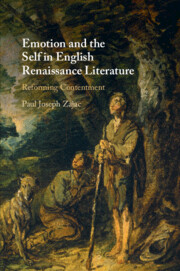Book contents
- Emotion and the Self in English Renaissance Literature
- Emotion and the Self in English Renaissance Literature
- Copyright page
- Dedication
- Contents
- Acknowledgments
- Introduction
- Chapter 1 Constructing Contentment in Reformation England
- Chapter 2 Romancing Contentment
- Chapter 3 Fashioning Contentment
- Chapter 4 Performing Contentment
- Chapter 5 Losing Contentment
- Conclusion
- Notes
- Bibliography
- Secondary Sources
- Index
Chapter 1 - Constructing Contentment in Reformation England
Published online by Cambridge University Press: 15 December 2022
- Emotion and the Self in English Renaissance Literature
- Emotion and the Self in English Renaissance Literature
- Copyright page
- Dedication
- Contents
- Acknowledgments
- Introduction
- Chapter 1 Constructing Contentment in Reformation England
- Chapter 2 Romancing Contentment
- Chapter 3 Fashioning Contentment
- Chapter 4 Performing Contentment
- Chapter 5 Losing Contentment
- Conclusion
- Notes
- Bibliography
- Secondary Sources
- Index
Summary
Chapter 1 investigates the English Reformation conversation on contentment, beginning with early sixteenth-century translations of St. Paul’s epistles and Martin Luther’s works and ending with texts from the English Revolution. Renaissance authors did not invent contentedness, but they drew upon available traditions to reinvent a contentment consistent with Protestant ideals and adapted to the needs of English audiences. Chapter 1 charts the role of contentment in Foxe’s Acts and Monuments, Burton’s Anatomy of Melancholy, Charles I’s Eikon Basilike, and Hobbes’s Leviathan, as well as an archive of sermons and theological treatises. First, it traces the notion of Christian contentment to two passages in 1 Timothy 6 and Philippians 4, which featured heavily in the cultural discourse. Next, it examines how reformers reconcile contentment, suffering, and even martyrdom. Then, it analyzes the relationship between contentment and contemporary theories of embodiment and the passions. Finally, it shows how authors extended individual contentedness to the body politic. During the Renaissance, contentment became a prominent Protestant principle of fortifying self and society.
Keywords
- Type
- Chapter
- Information
- Emotion and the Self in English Renaissance LiteratureReforming Contentment, pp. 20 - 49Publisher: Cambridge University PressPrint publication year: 2022

